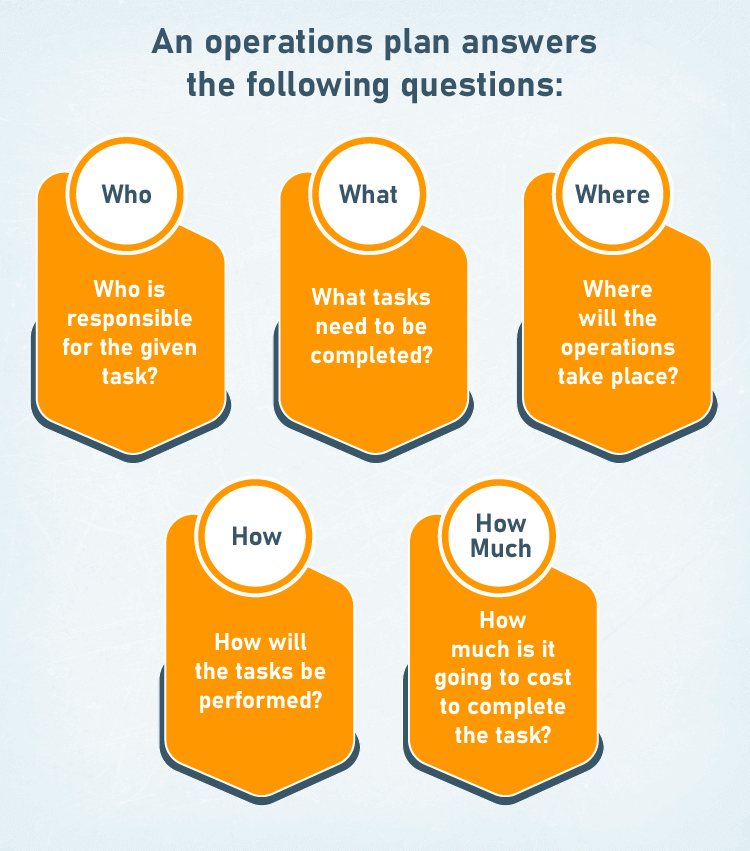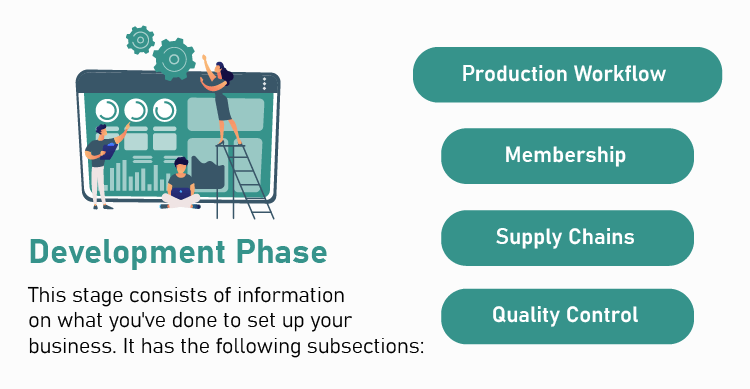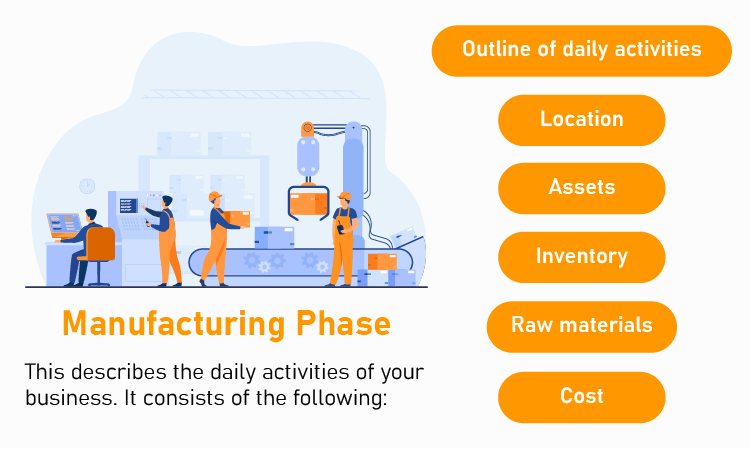 operational plan section of business plan" width="751" height="451" />
operational plan section of business plan" width="751" height="451" /> operational plan section of business plan" width="751" height="451" />
operational plan section of business plan" width="751" height="451" />
An operational plan bridges the gap between high ambitions and actual achievements. This essential integral section helps businesses thrive, achieve their goals, and handle challenges with accuracy and purpose.
But is it challenging for you to write one in a manner that shows a clear picture of your business operations? Drafting the operations plan section can be tricky due to the uncertainties of the business environment and the risks associated with it.
Well, worry not you’re at the right place! Here, we will see how to write an engaging operational plan in a business plan with an example. So let’s get going.
An operations plan of a business plan is an in-depth description of your daily business activities centered on achieving the goals and objectives described in the previous sections of the plan. It outlines various departments’ processes, activities, responsibilities, and execution time frame.
The operations section explains in detail the role of a team or department in the collective accomplishment of your goals. In other words, it’s a strategic allocation of physical, financial, and human resources toward reaching milestones within a specific timeframe.

A successful operational plan section of your business plan should be able to answer the following questions:
Let’s see how to write the operations section that answers all the above questions:
Create winning business plans with our
AI Business Plan Generator
Plans starting from $7/month

Writing an operations plan within a business plan involves summarizing the day-to-day tasks necessary to run the business efficiently and meet its goals in both the development and manufacturing phases of the business.
Here’s a step-by-step guide:

In this stage, you mention what you’ve done to get your business operations up and running. Explain what you aim to change and improvise in the process. These are the elements your development section will contain:
Explain all the steps involved in creating your product. Provide a detailed description of each step, including any inefficiencies and the actions needed to address them. Here, you also mention any inefficiencies that exist and talk about the actions that need to be taken to tackle them.
Write down the risks involved in the production and potential problems you may face later down the line. State the safety measures employees take to avoid any misfortune while working. Explain how you store hazardous material and discard waste.
Mention any industry organizations and associations you’re a part of or plan to join. It’s essential to include this information to convey to the reader that you’re aware of the organizations and associations in your industry.
Here, you mention the vendors you work with to sell your products. Give a quick rundown of the agreements you signed with them. Mention the terms and conditions, prices, and timeframe of the contract. You can also mention if you have any backup suppliers if the existing ones fail to fulfill the requirements.
Describe the measures you’re taking to assure and verify the quality of the end product. If you’re working towards getting a product certification, explain the steps you take to meet the set standards.

The development stage acquaints the reader with the functioning of your business, while the manufacturing stage describes the day-to-day operation. This includes the following elements:
Create an outline of the day-to-day activities of the production process. This includes the hours of operation, days the business will be open, and whether the business is seasonal or not.
Mention the location of your business, other branches you have, and their locations. If available, include images or drawings of the buildings, lease documents, real estate agreements, and other relevant documents. If you include these in your plan, mention why they’re crucial.
Describe the tools and machinery you use. You should also include the cost of the equipment; these will be important to predict financial requirements.
List down all your assets. These include land, buildings, tools, machinery, vehicles, and furniture. Include a legal description and the value of these assets.
If you require any additional facilities like water supply or power requirements, you mention them here. Specify what you need to do or have already done to acquire permissions for these requirements.
Mention your raw material suppliers. If you need any extra materials, you can also include them in your operations plan. Here, you also mention the contracts and agreements with your suppliers.
Explain the production process and the time required to produce one unit. Include the factors that may disrupt the production flow. Further, mention your strategies to tackle these inefficiencies to avoid delays in manufacturing.
Here, you state the process of storing manufactured products, managing the stock, and the costs of the storage spaces. Stringent management of inventory is essential to maintain product quality and assure customer satisfaction.
To ensure the viability and effectiveness of your product, detail any tests it has undergone. This includes prototype testing to evaluate the design and functionality.
Additionally, highlight product or service testing, such as performance, safety, and user experience assessments. These tests validate your product’s readiness for the market, ensuring it meets customers’ needs and regulatory standards.
Include the pricing strategy for your products or services. You can also include the final prices of your products.
Outline your pricing strategy including which approach you used, for example—cost-plus, value-based, or competitive pricing. Include the final prices of your products or services, providing a breakdown if there are different tiers or packages.
An operations plan is like an instruction manual for your business. It helps investors assess your credibility and understand the structure of your operations.
Internally, an operations plan works as a guide, which helps your employees and managers to know their responsibilities. It also helps them understand how to execute their tasks in the desired manner—all while keeping account of deadlines.
The operations plan helps identify and cut the variances between planned & actual performance and makes necessary changes.
It helps you visualize how your operations affect revenue and gives you an idea of when you need to implement new strategies to maximize profits. Some of the advantages of preparing an operations plan include:
Operational planning makes sure that everyone in the audience and team is aware of the daily, weekly, and monthly work. It improves concentration and productivity.
Operational planning makes it much easier to reach long-term objectives. When members have a clear business strategy to follow—productivity rises, and accountability is maintained.
It sets a clear goal for everyone about what is the destination of the company and how to reach it.
It supports you in allocating resources, such as human resources, equipment, and materials, ensuring that nothing is wasted and everything is used optimally.
An operations plan helps make smart decisions by showing how the business runs day-to-day. It provides details on resources, wise investments, and effective risk management, ensuring that decisions improve overall business operations.
Now that you have understood the importance of the operations plan, let’s go through the essentials of an operations plan:
Your operations plan is fundamentally a medium for implementing your strategic plan. Hence, it’s crucial to have a solid plan to write an effective operations plan.
Having clear goals is one of the most important things for an operations plan. For clear goals, you need to think SMART:
Different departments will have their objectives, all supporting the main goal. All these strategic objectives are flexible and should align with the company’s long-term goals.
It’s essential to choose the right Key Performance Indicators (KPIs). It’s a good practice to involve all your teams while you decide your KPIs. Some of the important KPIs can be revenue growth, customer acquisition cost (CAC), net profit margin, churn rate, etc.
Creating a timeline with milestones is necessary for any business. It keeps everyone focused and helps track efficiency. If some milestones aren’t met in a certain period, then it’s time to re-evaluate them.
Examples of some milestones are:
Now you’re all set to write an operations plan section for your business plan. To give you a headstart, we have created an operations plan example.
| Operations plan by a book publishing house | ||||
|---|---|---|---|---|
| Goal | Strategy | Actions | Responsibility | Deadlines |
| Save capital spent on the raw materials for book pages | Cost reduction | Negotiate with the raw materials supplier to reduce the price | Sean Davis | August 2024 |
| Increase the number of books proofread by 10% | Improve productivity | 1. Distribute manuscripts among all the editors to avoid burden on some. | ||
We know this guide has been helpful for you in drafting a comprehensive operational plan section for your business plan.
If you’re still unsure or need help getting started, consider using business plan software like Upmetrics. It offers step-by-step guidance, so you won’t have to worry about what comes next.
Build your Business Plan Faster
with step-by-step Guidance & AI Assistance.